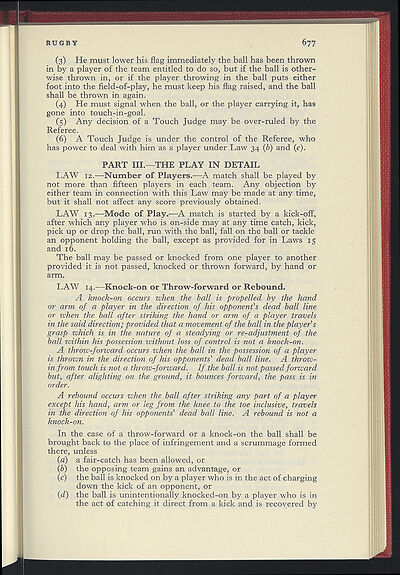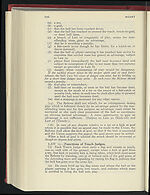1959-60
(749)
Download files
Complete book:
Individual page:
Thumbnail gallery: Grid view | List view

t
RUGBY
6'77
(3) He must lower his flag immediately the ball has been thrown
in by a player of the team entitled to do so, but if the ball is other-
wise thrown in, or if the player throwing in the ball puts either
foot into the field-of-play, he must keep his flag raised, and the ball
shall be thrown in again.
(4) He must signal when the ball, or the player carrying it, has
gone into touch-in-goal.
(5) Any decision of a Touch Judge may be over-ruled by the
Referee.
(6) A Touch Judge is under the control of the Referee, who
has power to deal with him as a player under Law 34
(b)
and (c).
PART III.—THE PLAY IN DETAIL
LAW
i2.—Number of Players.
—A match shall be played by
not more than fifteen players in each team. Any objection by
either team in connection with this Law may be made at any time,
but it shall not affect any score previously obtained.
LAW
13.—Mode of Play.
—A match is started by a kick-off,
after which any player who is on-side may at any time catch, kick,
pick up or drop the ball, run with the ball, fall on the ball or tackle
an opponent holding the ball, except as provided for in Laws
15
and 16.
The ball may be passed or knocked from one player to another
provided it is not passed, knocked or thrown forward, by hand or
arm.
LAW i4.—
Knock-on or Throw-forward or Rebound.
A
knock-on occurs when the ball is propelled by the hand
or arm of a player in the direction of his opponent's dead ball line
or when the ball after striking the hand or arm of a player travels
in the said direction; provided that a movement of the ball in the player's
grasp which is in the nature of a steadying or re-adjustment of the
ball within his possession without loss of control is not a knock-on.
A
throw forward occurs when the ball in the possession of a player
is
thrown in the direction of his opponents' dead ball line.
A
throw-
in from touch is not a throw forward. If the ball is not passed forward
but, after alighting on the ground, it bounces forward, the pass is in
order.
A
rebound occurs when the ball after striking any part of a player
except his hand, arm or leg from the knee to the toe inclusive, travels
in the direction of his opponents' dead ball line.
A
rebound is not a
knock-on.
In the case of a throw-forward or a knock-on the ball shall be
brought back to the place of infringement and a scrummage formed
there, unless
(a)
a fair-catch has been allowed, or
(b)
the opposing team gains an advantage, or
(c) the ball is knocked on by a player who is in the act of charging
down the kick of an opponent, or
(d)
the ball is unintentionally knocked-on by a player who is in
the act of catching it direct from a kick and is recovered by
i
J.
RUGBY
6'77
(3) He must lower his flag immediately the ball has been thrown
in by a player of the team entitled to do so, but if the ball is other-
wise thrown in, or if the player throwing in the ball puts either
foot into the field-of-play, he must keep his flag raised, and the ball
shall be thrown in again.
(4) He must signal when the ball, or the player carrying it, has
gone into touch-in-goal.
(5) Any decision of a Touch Judge may be over-ruled by the
Referee.
(6) A Touch Judge is under the control of the Referee, who
has power to deal with him as a player under Law 34
(b)
and (c).
PART III.—THE PLAY IN DETAIL
LAW
i2.—Number of Players.
—A match shall be played by
not more than fifteen players in each team. Any objection by
either team in connection with this Law may be made at any time,
but it shall not affect any score previously obtained.
LAW
13.—Mode of Play.
—A match is started by a kick-off,
after which any player who is on-side may at any time catch, kick,
pick up or drop the ball, run with the ball, fall on the ball or tackle
an opponent holding the ball, except as provided for in Laws
15
and 16.
The ball may be passed or knocked from one player to another
provided it is not passed, knocked or thrown forward, by hand or
arm.
LAW i4.—
Knock-on or Throw-forward or Rebound.
A
knock-on occurs when the ball is propelled by the hand
or arm of a player in the direction of his opponent's dead ball line
or when the ball after striking the hand or arm of a player travels
in the said direction; provided that a movement of the ball in the player's
grasp which is in the nature of a steadying or re-adjustment of the
ball within his possession without loss of control is not a knock-on.
A
throw forward occurs when the ball in the possession of a player
is
thrown in the direction of his opponents' dead ball line.
A
throw-
in from touch is not a throw forward. If the ball is not passed forward
but, after alighting on the ground, it bounces forward, the pass is in
order.
A
rebound occurs when the ball after striking any part of a player
except his hand, arm or leg from the knee to the toe inclusive, travels
in the direction of his opponents' dead ball line.
A
rebound is not a
knock-on.
In the case of a throw-forward or a knock-on the ball shall be
brought back to the place of infringement and a scrummage formed
there, unless
(a)
a fair-catch has been allowed, or
(b)
the opposing team gains an advantage, or
(c) the ball is knocked on by a player who is in the act of charging
down the kick of an opponent, or
(d)
the ball is unintentionally knocked-on by a player who is in
the act of catching it direct from a kick and is recovered by
i
J.
Set display mode to:
![]() Universal Viewer |
Universal Viewer | ![]() Mirador |
Large image | Transcription
Mirador |
Large image | Transcription
| Games and sports in the army > 1959-60 > (749) |
|---|
| Permanent URL | https://digital.nls.uk/248872775 |
|---|
| Description | 'Games and Sports in the Army' was an annual publication produced by the British War Office between the 1930s and 1960s. This included the Second World War. It outlines the rules and regulations for games and sports played by members of the armed forces. It features names and photographs of team members, and examples of contemporary advertising. |
|---|---|
| Shelfmark | GWB.52 |

